Top News
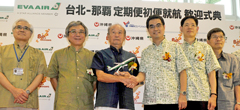
June 18, 2014 Ryukyu Shimpo
EVA Airways, a leading airline based in Taiwan, launched flights between Taipei and Naha for the first time on June 17. It is the fourth company to operate flights on the route, following China Airlines, TransAsia Airways and LCC airline Peach Aviation. EVA Airways uses Airbus A321-200 with 184-seat Airbus.
The first flight from Taipei to Naha was fully booked. The company is aiming for a 95 percent boarding rate in the summer high season. During the summer vacation season, the company plans to increase flights to two round-trips per day from the current one round trip per day.
On the same day, the Okinawa Convention & Visitors Bureau (OCVB) and Okinawa Prefectural Government held a welcome ceremony at the international passenger terminal building of Naha Airport. Okinawa Governor Hirokazu Nakaima, Yoshiyuki Uehara, the president of the OCVB and Su Chii-cherng, head of Naha Branch of Taipei Economic and Cultural Representative Office in Japan and others attended.
Governor Nakaima said in his greeting, “We welcome EVA Airways to begin its service. This will help encourage further people-to-people exchanges between Okinawa and Taiwan. We expect more Taiwanese tourists to visit Okinawa.”
Vice president of EVA Airways Glenn Chai said, “The Naha-Taipai line, which is our shortest route, is the 11th route of our company in Japan. We expect this route to become the most popular destination.”
(English translation by T&CT)
Go to Japanese
June 21, 2014 Ryukyu Shimpo
On June 20, the Okinawa Defense Bureau revealed that a part of an MV-22 Osprey aircraft belonging to the U.S. Marine Corps Air Station Futenma had fallen. It is speculated that the accident occurred between the afternoon and night on June 17. The Okinawa Defense Bureau received a report from U.S. forces in Japan through the Ministry of Defense on June 19 two days after the accident. On the same day, the defense bureau reported the accident to the Okinawa Prefectural Government and Ginowan City Office. However, information on the location of the missing part has not yet been provided by US Marine Corps.
The U.S. Marine Corps emphasized that there was no damage. According to the U.S. Marine Corps, a pen-sized part fell from the airplane on the sea during routine flight training, and no injury has been reported. The U.S. Marines did not reply to a question from Ryukyu Shimpo regarding why they delayed reporting it for two days to the Japanese side. On June 20, the Okinawa Prefectural Government and Ginowan City Office asked the U.S. military to ensure they would take steps to prevent a recurrence and be more thorough in safety management. In February 2013, a full bottle of water fell from an Osprey aircraft belonging to the Futenma base during a flight near the base. It is the first time that a part has fallen from an Osprey aircraft.
In 1997, the governments of Japan and the United States agreed that the U.S. military has to report accidents, including objects fallen from U.S. aircraft, to the Japanese side as soon as possible, regardless of whether incidents took place inside or outside the base. According to the defense bureau, the fallen part is a 15 centimeter, stick-shaped piece of equipment, which is attached to the vertical stabilizer at the rear part of the aircraft. This is mounted on the body in order to discharge static electricity. During a routine maintenance check after the airplane returned to the base at around 11:00 p.m. on June 17 it was found that the part had been lost. The airplane took off from the Futenma base at 5:00 p.m. and flew over the sea near the main Island.
The U.S. Marine Corps has not yet disclosed the flight route of the airplane, or the location where the Osprey lost the rod-shaped static discharger. However, Marine officials say they take the safety of local residents seriously.
(English translation by T&CT)
Go to Japanese
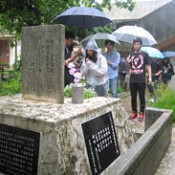
June 19, 2014, Mitsuo Kochi correspondent of Ryukyu Shimpo
On June 14, a peace project titled “Thinking about the Battle of Okinawa in Yambaru with High School Students” with the themes of the Battle of Okinawa and the U.S. military bases was held. The Nago City School Board sponsors and carries out the project each year. This is the 20th event. This year, participants learned about “Futenma Air Station,” “The U.S.military jet crash onto Miyamori Elementary School in 1959,” and “The relocation of Futenma Air Station to Henoko.”
A total of 82 people, including students from Nago High School, Nago Commercial and Industrial School, Northern Agriculture and Forestry High School, Hentona High School, Motobu High School, Hokuzan High School, Ginoza High School, Okinawa Vocational High School and community members took part. Participants went around Kakazu Hill in Ginowan City, Miyamori Elementary School, and Henoko.
At Kakazu Hill, former Ginowan mayor Yoichi Iha explained the background and current situation of the US military base’s construction. Looking at the Futenma Air Station under heavy rain, one of the high-school students pointed out, “The runway extends to right near the residential area.”
At the Miyamori Elementary School in Ishikawa, Uruma City, Masaharu Kudaka, who was in the fifth grade at the time of the accident, told his story in front of photographs and panels. Hideko Ogido from Nago Commercial and Industrial High School remarked, “I was really shocked by the accident. Why do Okinawan people have to be afraid of the U.S. military personnel even after the war?”
Many of the high-school students said they were shocked that the aircraft had crashed into Miyamori Elementary School. They all prayed for the victims by dedicating chrysanthemum flowers at the crash site.
At Henoko, Tsutomu Nakasone from the Nago City Office explained the historical background of moving Futenma Air Station to Henoko.
Hibiki Kobashigawa said, “The Miyamori Elementary School accident was horrifying. As we learned about the plan to build a new military base in Henoko, I realized accidents like Miyamori Elementary School concern us, too.” Yuki Oshiro said, “It will be too late to solve the issues after accidents and incidents related to military bases happen.”
(English translation by T&CT and Megumi Chibana)
Go to Japanese
June 19, 2014 Ryukyu Shimpo
Special Natural Monument the Okinawa woodpecker, which lives mainly in three villages, including Kunigami, Ogimi and Higashi, has moved its habitat to mountain forest in the Genka district of Nago. The Yambaru Wildlife Conservation Center confirmed the habitat shift on June 6.
According to the center, the birds breed in Onna Village. However, there has been no clear evidence to confirm this report. This is the first time the birds were confirmed to have bred in Nago.
Yutaka Toguchi of the Ministry of the Environment confirmed the presence of an adult female bird and a chick on June 6 and an adult male bird on June 7.
The center could not find nesting trees of the birds. However, they determined that the birds breed in the Nago area because the Okinawa woodpecker has a habit of staying near the nesting trees in breeding season. An adult male Okinawa woodpecker was seen in the Nago area in 2013.
(English translation by T&CT)
Go to Japanese
June 18, 2014 Ryukyu Shimpo
The Supreme Court has rejected an appeal by a resident of Takae in Higashi, where the U.S. military plans to build military helipads as a condition of the partial return of its Northern Training Area. Residents of Takae have been protesting against construction of the helipads. In response, the Okinawa Defense Bureau filed a lawsuit seeking a ban against obstructing passage in the area. On June 17, the second petty bench of the Supreme Court, headed by Justice Kaoru Onimaru, turned down an appeal by Masatsugu Isa, 52, against the lawsuit. In the ruling, the court ordered that Isa “will not physically obstruct the country’s use of roads.” The court gave its ruling on June 13.
The court has stated that they turned down the appeal because the lawsuit did not go against the Constitution. However, the court did not provide a detailed explanation for the ruling. Also, the court did not provide a detailed explanation for not accepting a petition for a final appeal.
The government’s filing of civil suits against individual citizens involved in protests have drawn criticism from many intellectuals nationwide, attracting the tag “SLAPP” suit, a strategic lawsuit against public participation. Isa claimed that this was an abuse of the legal process. However, the court rejected his appeal.
In the initial judgment by the Naha District Court, the court judged Isa as guilty because he raised his hands high between Okinawa Defense Bureau workers as they were unloading sandbags from a truck.
Isa asserted that protests are necessary to ensure a peaceful region to live in where there are no military bases. He filed an appeal stating the judgment “violates Article 21 Section 1 of the Constitution, which guarantees the freedom of expression.”
In response to the ruling, the Association of Residents Against the Helipad and Lawyers Against the Helipad have released a joint statement. They stated, “It is an extreme injustice to ignore the fact that the residents’ protest activities are based on the right to freedom of expression, and to ignore the precedents that have been set in the past.”
An official of the Okinawa Defense Bureau stated, “We need to build a helicopter landing area to fulfill the final agreement for the return of more than half of the Northern Training Area based on the Special Action Committee on Facilities and Areas in Okinawa (SACO). We are carrying it out to reduce the burden on the citizens of Okinawa. We will work steadily towards fulfilling this agreement.”
(English translation by T&CT and Lima Tokumori)
Go to Japanese
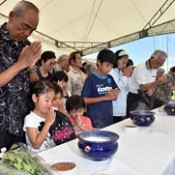
June 24, 2014 Ryukyu Shimpo
A ceremony to mark the 69th anniversary of the end of the Battle of Okinawa was held at the Peace Memorial Park, Mabuni in Itoman on June 23. The participants prayed for over 200,000 victims of the war and reaffirmed their commitment to lasting world peace.
The services were held at war memorials all around Okinawa, and attended by many Okinawan people who prayed for the victims of the war.
Following Okinawa Governor Hirokazu Nakaima’s approval of the Henoko landfill last December, the Japanese government has been pressing forward with its plan to build a new U.S. military base to replace Marine Corps Air Station Futenma in Henoko, Nago. Many Okinawan people oppose the plan. The chairwoman of Bereaved Families of Okinawa Prefecture War Dead Joint Association Naeko Teruya advocated for the base to be moved outside Okinawa. Masaharu Kina, the chairman of the Okinawa Prefectural Assembly asked for swift closure and removal of the base.
In his peace declaration for the ceremony, Nakaima stated, “I will do my best to lessen the base-hosting burden on the people of Okinawa, including relocating the base outside Okinawa.”
Participants at the memorial services voiced protest against the Abe administration’s reinterpretation or revision of the Constitution of Japan, which will allow Japan to use the right to collective defense.
From early morning, there was a continuous stream of bereaved families visiting the memorial park. Some of them dedicated flowers with their children and grandchildren in front of the Cornerstone of Peace memorial where the names of victims are inscribed. Others traced their fingers over the names of their parents and relatives.
A peace march dedicated to the war dead started at Itoman City Office at 9:00 p.m. The participants marched through the war sites in the southern parts of the prefecture. They then took part in the ceremony and prayed.
According to the organizer, about 4,600 people took part. The ceremony had about 5,800 attendees last year. At noon, participants fell silent in honor of the war dead.
Prime Minister Shinzo Abe, Speaker of the House of Representatives of Japan Bunmei Ibuki and House of Councillors President Masaaki Yamazaki, and U.S. ambassador to Japan Caroline Kennedy attended the ceremony.
Takeru Masuda of Ishigaki City Makira Elementary School read out a poem, which drew a big applause.
The peace memorial had 54 more names added. The number of inscribed names on the memorial reached 241,281.
(English translation by T&CT)
Go to Japanese
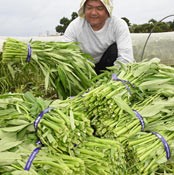
June 10, 2014 Ryukyu Shimpo
The harvesting of summer vegetable water spinach, or uncheba in Okinawan dialect, has begun. On June 9, as the rainy season was coming to an end, Katsuaki Higa harvested freshly grown uncheba at his vegetable field in Tagami, Tomigusuku. The village’s harvest season is from May until September. Called yousai or ensai in Japanese, Water spinach is a popular vegetable used in Chinese cooking. People can taste the crispy and slight texture of uncheba, which has hollow stems.
Higa said, “Stir frying water spinach with pork belly is very delicious and cooking it in soup is also good. Cooking young leaf of uncheba grown in rainy season is most delicious.”
(English translation by T&CT, Hitomi Shinzato)
Go to Japanese
June 17, 2014 Ryukyu Shimpo
China’s LCC Spring Airlines will launch flights between Shanghai and Naha in August. It plans to run four round trips per week using Airbus A320 aircraft. The company has applied to China Civil Aviation Administration for approval to operate the service. This is the first low-cost carrier between mainland China and Naha. Currently, between Shanghai and Naha, China Eastern Airlines operates 11 round trips per week, Juneyao Airlines flies four round-trips per week. Spring Airlines will be the third company to provide flight service between Shanghai and Naha.
Shanghai-based Spring Airlines operates flights to about 50 domestic destinations. These include Osaka and Ibaraki in Japan.
Tatsuo Kinjo, the director of the Shanghai office of the Okinawa Prefectural Government, commented, “The number of Chinese tourists visiting the resorts in the Philippines and Vietnam has decreased recently. Conversely, Japan and Korea have attracted Chinese tourists. We welcome Spring Airlines’ commencement of services to Naha. More Chinese tourists will be able to visit Okinawa from Shanghai easily.”
(English translation by T&CT)
Go to Japanese

June 15, 2014 Yoko Morinaga, correspondent of the Ryukyu Shimpo
A fisherman from Kumejima, now in the middle of bluefin tuna fishing season, caught a giant bluefin tuna weighing 330 kilograms and measuring 2.5 meters in length on June 16th. Seiji Higa is captain of Kumi Maru, a vessel belonging to the Fisheries Cooperative Association of Kumejima Island. After catching the fish, Higa returned to Kanegusuku port, where locals and the people involved gathered and applauded his achievement.
Higa said, “At first, I thought I caught a Marlin. However, it turned out to be a bluefin tuna. So, I was happy.”
This is the second time a bluefin tuna has been caught this year. Yoshinori Yoza caught one weighing 360 kilograms on June 6.
(English translation by T&CT)
Go to Japanese
June 13, 2013 Ryukyu Shimpo
In the run-up to the prefectural gubernatorial election this fall, members of the Okinawan business community, including chairman of Kanehide Holdings Co., Ltd Morimasa Goya and CEO of Kariyushi Co., Ltd Chokei Taira held a press conference at the Okinawa Prefectural Government Office in the morning on June 12. They announced that they had set up a new organization, the “Association for the Governorship of Takeshi Onaga.” They aim to attract widespread support from the Okinawan business community in favor of Naha Mayor Takeshi Onaga’s bid to become the new governor of Okinawa Prefecture. Goya and Taira will be joint representatives of the organization and Kanehide Holdings founder Hidenobu Goya and Okinawa Ham Co., Ltd Chairman Tokumatsu Nagahama will be advisers. Other companies joining the association will support the founders’ aims.
Within the next two months, the organization will hold a larger meeting with other supporters. The advisory committee will also be looking for representatives from companies that run tourist facilities.
Goya stated, “I would like to back Onaga for governor, and achieve our goal.” He expects to garner the support of over 100 companies.
Taira views Okinawa Governor Hirokazu Nakaima’s decision to approve the reclamation of the Henoko district in Nago as “A total act of betrayal.” He claimed, “We must elect a new leader.” He cites this as the reason for supporting Onaga.
Goya said, “Onaga was a campaign manager for Nakaima in the previous gubernatorial election, and opposed building of a military base in Henoko. Now the situation has come to this, I hope for a new governor. Creating new industries and building new commercial districts such as the Shintoshin area of Naha is desirable.”
Okiham’s chairman Nagahama was present at the press conference and said, “Okinawa is now reaching a major turning point. Without Onaga, we cannot move ahead.”
(English translation by T&CT and Lima Tokumori)
Go to Japanese
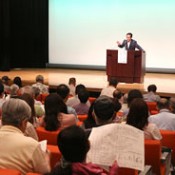
June 16, 2014 Ryukyu Shimpo
Okinawa International University Professor Shinobu Yoshihama held a lecture to mark the 69th anniversary of the end of the Battle of Okinawa at the Okinawa Prefectural Museum & Art Museum in Naha on June 15. He talked about what the testimonies of local citizens and the Japanese Imperial Army documents revealed about the war. About 160 people took part in the lecture and listened intently to what Yoshihama said.
Yoshihama said, “After the battle of Okinawa, there have been turning points in Okinawan history, such as Okinawa’s reversion to Japanese sovereignty and erection of the Cornerstone of Peace memorial. On these occasions, the prefectural and municipal governments published history books.” He went on to say, “Every time historical events have occurred, Okinawan people have reflected on the Battle of Okinawa and thought about the future.”
Yoshihama introduced the Japanese Imperial Army documents, in which they suspected some of the Okinawan residents who fled from the Nakagami district, and asked about the location of shelters and troops, as spies for the U.S. military. He said, “The residents who fled from Ginowan and Kitanakagusuku testified that the Japanese Imperial Army suspected them as spies. I did not know why the army did so until I read their documents.”
A student who attended the talk, Yurino Oshiro, from Itoman, said, “I think the army documents were intriguing because I used to read many documents written only by the local residents. It is important to see the Battle of Okinawa from a new perspective.”
(English translation by T&CT)
Go to Japanese






 Webcam(Kokusai Street)
Webcam(Kokusai Street)


